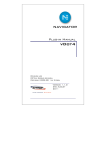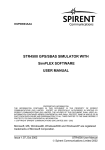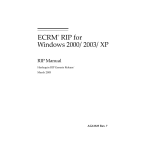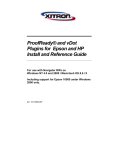Download Harlequin RIP
Transcript
vDot4 plugin for Epson variable dot 8-color printers Version 4.10 August 2011 Copyright and Trademarks vDot4plugin Version 4.10 Document issue 102 Part number: HQ-vDot4 August 2011 Portions Copyright © 2011 Global Graphics Software Ltd. All rights reserved. Certificate of Computer Registration of Computer Software. Registration No. 2006SR05517 No part of this publication may be reproduced, stored in a retrieval system, or transmitted, in any form or by any means, electronic, mechanical, photocopying, recording, or otherwise, without the prior written permission of Global Graphics Software Ltd. The information in this publication is provided for information only and is subject to change without notice. Global Graphics Software Ltd and its affiliates assume no responsibility or liability for any loss or damage that may arise from the use of any information in this publication. The software described in this book is furnished under license and may only be used or copied in accordance with the terms of that license. Harlequin is a registered trademark of Global Graphics Software Ltd. The Global Graphics Software logo, the Harlequin at Heart Logo, Cortex, Harlequin RIP, Harlequin ColorPro, EasyTrap, FireWorks, FlatOut, Harlequin Color Management System (HCMS), Harlequin Color Production Solutions (HCPS), Harlequin Color Proofing (HCP), Harlequin Error Diffusion Screening Plugin 1-bit (HEDS1), Harlequin Error Diffusion Screening Plugin 2-bit (HEDS2), Harlequin Full Color System (HFCS), Harlequin ICC Profile Processor (HIPP), Harlequin Standard Color System (HSCS), Harlequin Chain Screening (HCS), Harlequin Display List Technology (HDLT), Harlequin Dispersed Screening (HDS), Harlequin Micro Screening (HMS), Harlequin Precision Screening (HPS), HQcrypt, Harlequin Screening Library (HSL), ProofReady, Scalable Open Architecture (SOAR), SetGold, SetGoldPro, TrapMaster, TrapWorks, TrapPro, TrapProLite, Harlequin RIP Eclipse Release and Harlequin RIP Genesis Release are all trademarks of Global Graphics Software Ltd. Protected by U.S. Patents 5,579,457; 5,808,622; 5,784,049; 5,862,253; 6,343,145; 6,330,072; 6,483,524; 6,380,951; 6,755,498; 6,624,908; 6,809,839. Other U.S. Patents Pending Protected by European Patents 0 803 160; 0 772 934; 0 896 771; 672 29 760.8-08. Portions licensed under U.S. Patent No. 5,212,546; 4,941,038. TrueType is a registered trademark of Apple Computer, Inc. The ECI and FOGRA ICC color profiles supplied with this Harlequin RIP are distributed with the kind permission of the ECI (European Color Initiative) and FOGRA respectively, and of Heidelberger Druckmaschinen AG (HEIDELBERG). The IFRA ICC profiles supplied with this Global Graphics Software are distributed with the kind permission of IFRA and of GretagMacbeth. International Cooperation for Integration of Processes in Prepress, Press and Postpress, CIP4, Job Definition Format, JDF and the CIP4 logo are trademarks of CIP4. Adobe, Adobe Photoshop, Adobe Type Manager, Acrobat, Display PostScript, Adobe Illustrator, PostScript, Distiller and PostScript 3 are either registered trademarks or trademarks of Adobe Systems Incorporated in the United States and/or other countries which may be registered in certain jurisdictions. Global Graphics Software Ltd is a licensee of Pantone, Inc. PANTONE® Colors generated by ScriptWorks are four-color process simulations and may not match PANTONE-identified solid color standards. Consult current ® ® PANTONE Color Publications for accurate color. PANTONE , Hexachrome , and PANTONE CALIBRATED™are trademarks of Pantone, Inc. © Pantone, Inc., 1991. Other brand or product names are the registered trademarks or trademarks of their respective holders. CONTENTS ii CONTENTS iii US Government Use Harlequin RIP software is a computer software program developed at private expense and is subject to the following Restricted Rights Legend: “Use, duplication, or disclosure by the United States Government is subject to restrictions as set forth in (i) FAR 52.227-14 Alt III or (ii) FAR 52.22719, as applicable. Use by agencies of the Department of Defense (DOD) is subject to Global Graphics Software’s customary commercial license as contained in the accompanying license agreement, in accordance with DFAR 227.7202-1(a). For purposes of the FAR, the Software shall be deemed to be ‘unpublished’ and licensed with disclosure prohibitions, rights reserved under the copyright laws of the United States.” Global Graphics Software Incorporated, 31 Nagog Park, Suite 315, Acton MA 01720. CONTENTS iii Contents 1 2 3 4 5 6 7 8 Introduction . . . . . . . . . . . . . . . . . . . . . . . . . . . . . . . . . . . . . . . . . . . . . . . . . . . . . . . . . . . . . . . . . 1 Supported printers and media . . . . . . . . . . . . . . . . . . . . . . . . . . . . . . . . . . . . . . . . . . . . . . . . . 1 System requirements . . . . . . . . . . . . . . . . . . . . . . . . . . . . . . . . . . . . . . . . . . . . . . . . . . . . . . . . . 1 Installation . . . . . . . . . . . . . . . . . . . . . . . . . . . . . . . . . . . . . . . . . . . . . . . . . . . . . . . . . . . . . . . . . . 2 Set up the RIP for proofing . . . . . . . . . . . . . . . . . . . . . . . . . . . . . . . . . . . . . . . . . . . . . . . . . . . . 5 Creating a Page setup. . . . . . . . . . . . . . . . . . . . . . . . . . . . . . . . . . . . . . . . . . . . . . . . . . . . . . . . . 6 Testing the vDot4 plugin installation. . . . . . . . . . . . . . . . . . . . . . . . . . . . . . . . . . . . . . . . . . . 12 Calibration . . . . . . . . . . . . . . . . . . . . . . . . . . . . . . . . . . . . . . . . . . . . . . . . . . . . . . . . . . . . . . . . . 13 CONTENTS iv vDot4 plugin for Epson printers Note to OEMs: This document is presented for inclusion in end-user documentation such as a manual based upon the Harlequin RIP OEM Manual, or for use as a supplement to that manual. You may wish to change the introduction to this document to suit the presentation you choose. (Notes like this one are not meant for onward publication to end-users. They give information of interest only to staff at GGSL and its OEMs.) 1 Introduction ™ This manual describes the Harlequin RIP vDot4 plugin for Epson Variable Dot 8-color printers. The vDot4 plugin provides high quality proofing capability to Global Graphics Harlequin RIPs driving Epson Variable Dot printers. To use the vDot4 plugin read this documentation to understand the procedures involved with successful use of this product. This manual guides you through the installation procedure and describes how to print test output jobs from your RIP on a color printer. Pre-calibrated color is available for the Epson “Ultrachrome HDR” Ink Set only. Users of other ink sets must provide their own calibration and color management profiles. 2 Supported printers and media This sections describes the printers and media supported. 2.1 Printers The vDot4 plugin supports the following Epson Variable Dot 8-color printers: Epson Stylus Pro 4900, 7890, 7900, 9890, 9900. 2.2 Media There are many types of media marketed for use with ink jet printers from various printer manufacturers and other third party vendors. Many of these media have similar names which can be confusing. For example Epson’s Photo Quality Glossy Paper, Glossy Photo Paper and Photo Glossy Paper are all different products with different characteristics, while Epson’s SemiGloss Paper-Heavy Weight and Semigloss Photo Paper are in fact the same product, sold under different names in different locations. The vDot4 plugin includes a library of calibrations for specific media, and accurate results are only possible if the correct medium is used. 3 System requirements To use the vDot4 plugin you must have a Harlequin RIP that meets the requirements listed below. Assuming the RIP is operational, you must resolve any outstanding RIP issues before installing the CONTENTS 1 OKI PCL PLUGIN CONTENTS 2 plugin. This manual only describes the additional information required for the vDot4 plugin, and does not attempt to cover all of the RIP features and requirements. To operate correctly the vDot4 plugin requires the following system resources: • v8.0 or later Harlequin Server RIP. • A Windows Server 2003 and 2008, Windows XP Pro, Windows Vista or Windows 7 equipped 32 or 64-bit PC. • 1 GHz recommended. • Minimum 2 GB RAM. • 2 GB free disk space. • The correct Epson Windows printer driver. • Connection interface, either: Ethernet supporting TCP/IP USB 2.0 (USB 1.1 compliant) 4 Installation This section describes how to add the vDot4 plugin to the Harlequin Server RIP. 4.1 PC platform installation Use this section to correctly install the PC platform. 4.1.1 Check your RIP configuration Use the Harlequin RIP > About Harlequin RIP menu selection to check the version of your RIP. The vDot4 plugin requires version 8.0 or later. If your version is older, please contact your supplier for an upgrade. The upgrade must be installed and configured with your imagesetter before continuing to install the plugin. 4.1.2 Epson Windows driver Before continuing, install the Epson Windows printer driver for your printer model and output a test page through the driver. Epson posts the latest drivers on their web site at: http://www.epson.com. This manual assumes that you have installed the driver that applies to your printer(s), and that its name is “EPSON Stylus Pro 4900”, “EPSON Stylus Pro 7890 or 9890”, “EPSON Stylus Pro 7900 or 9900”, as appropriate. (You can use other names if you wish, provided that you configure the RIP for the correct name, as described later in this manual.) 4.1.3 Configure and test the Windows printer driver To configure and test a Windows printer driver, proceed as follows (this example shows the Stylus Pro 7900 and 4900): 1. Click Start and select Devices and Printers or Printers and Faxes. CONTENTS 2 OKI PCL PLUGIN CONTENTS 2. 3 Highlight the item EPSON Stylus Pro 7900 (for example), right click and select Printer Properties. This displays the following dialog: Figure 1 Windows printer Advanced tab 3. Select the Advanced tab. 4. Select Spool print documents…. For maximum throughput (proofs-per-hour) select Start printing after last page… For the shortest time to process individual proofs, select Start printing immediately. 5. Select the Ports tab. Figure 2 Windows driver Ports tab CONTENTS 3 OKI PCL PLUGIN CONTENTS 4 6. Ensure the port shown is your preferred connection method. The Epson drivers provide flexibility of interconnection by using any method supported by the Windows printer driver. In this example a TCP/IP port is shown. 7. Select the General tab and click Print test page to test the Windows driver, printer and connection method. Resolve any problems at this stage before installing the plugin or launching the RIP. If you experience any difficulties at this stage, consult your Epson documentation and Epson online help resources. 4.2 Install the vDot4 plugin To install the plugin: 1. Double-click the file vDot4.exe. Select Next > to move forward to the next screen. Use <Back to return to a previous screen. Click Next > to display the Destination folder dialog. 2. Select the folder containing the Harlequin RIP which you want to use this plugin: Figure 3 3. Destination folder screen Ensure the Destination folder screen displays the correct location for the RIP to which you are installing the plugin. If it is not correct, use the Change… button to locate the correct folder and click Next >. Note: If the location selected is not a valid Harlequin RIP folder, the installation wizard will not move on to the next dialog. 4. When the Confirmation dialog is displayed select Next > to start the install. The installer copies the plugin and support files to the RIP, for Epson Stylus Pro 4900, 7890, 7900, 9890 and 9900 printer models. During this process progress information is displayed. 5. When the installer has finished a completion dialog is displayed. Click Finish to exit. The installer creates a folder called vDot4 containing Uninstall vDot4 in Start > All Programs, should you wish to uninstall the plugin at a later date. 4.3 Enabling plugins in the Harlequin RIP After installing the plugin files into your RIP, you must enable them in the Configure RIP Extras dialog before they can be used. To do this you will need your vDot4 plugin password, as supplied to you, as well as passwords for the ColorPro color management options which may be required. CONTENTS 4 OKI PCL PLUGIN CONTENTS 5 To enable the vDot4 Plug plugin and color management in the RIP, do the following: 1. Select Harlequin RIP > Configure RIP > Extras, to open the Configure RIP Extras dialog (Figure 4). Figure 4 2. Configure RIP Extras dialog From the list of RIP extras that are available, select X-EpsonvDot4, XXXX and click Add (where XXXX is the model number of the printer). 3. In the Enable Feature dialog (Figure 5), enter your vDot4 plugin password and click OK. Figure 5 Enable Feature password dialog The vDot4 plugin is now enabled in your RIP, as indicated by Enabled Yes in the Configure RIP Extras list. 4. If it is not already enabled and you want to use the ICC profiles made by the printer, you must enable Harlequin ColorPro in your RIP. Choose the appropriate option from the list, click Add and enter your ColorPro password. 5. When you have finished enabling the new RIP features click OK to close the Configure RIP Extras dialog, and OK again to close the Configure RIP dialog. You can now create page setups which use the vDot4 devices to process jobs for the various supported epson printers. 5 Set up the RIP for proofing Now that your vDot4 plugin is installed and enabled for use, you need to configure certain options in the RIP. These options are divided into: RIP memory settings, Device Manager settings and “Creating a Page setup” on page 6. CONTENTS 5 OKI PCL PLUGIN CONTENTS 6 5.1 RIP memory settings To configure the memory allocations for the RIP: With the RIP running select Harlequin RIP > Configure RIP > Options and ensure that the Memory for RIP and Allow use of all available memory options are not checked, and that the Memory reserve for RIP option displays 0. For the Minimum memory left for system (previously called Memory reserved for system) set it to 256 MB (by entering 256000). In the Configure RIP dialog set the Printer buffer enter 20000 Kb. Close the dialogs by clicking OK and re-start the RIP. 5.2 Device Manager settings The Device Manager allows you to select and name the output devices you will be using in the RIP. Select Harlequin RIP > Device Manager. The Plugin drop-down menu lists the names of the installed plugins. Check that the box shows the correct entry for the vDot4 plugin, EpsonVDot4.i32. Figure 6 Device Manager dialog Some entries may already be completed. If so, leave these, or re-name them to something you prefer. If you plan on using the pre-configured calibration and color management features of the vDot4 plugin, you must ensure that the Name you use is identical with the Type chosen, as in the example in Figure 6. You must have at least one Name entry for each different printer. The Color vDot device is a standard high-quality color device type using variable dot error diffusion screening, suitable for Sheet or Roll fed media. The next step is to configure specific details necessary to produce output. 6 Creating a Page setup This section describes the creation of one or more Page setups for your printer. A Page setup includes settings for printer, resolution, connection method, print quality and media selection (which also sets calibration and color management). CONTENTS 6 OKI PCL PLUGIN CONTENTS 7 The required items are described below: 1. Select Harlequin RIP > Page Setup Manager, to open the Page Setup Manager (Figure 7). Figure 7 2. Page Setup Manager In the Page Setup Manger, click New to create a new page setup (or Edit to amend an existing page setup), to open the New/Edit Page Setup dialog (Figure 8). Figure 8 Page Setup dialog 6.1 Printer model Choose the printer model and mode for this Page setup, by selecting the Devices drop-down menu. In this example the printer type 7890 Color vDot is selected. CONTENTS 7 OKI PCL PLUGIN CONTENTS 8 6.2 Page setup controls In the main page setup dialog you can choose the RIP resolution (but not Plotter resolution, which is set when you select your media in configuration, see “Output media and plotting resolution” on page 10), image orientation, scaling, calibration and color management. For further details about the settings in the Page setup dialog, see the Harlequin RIP User’s Guide. 6.3 RIP resolution Select the RIP resolution in the top right corner of the Page Setup dialog. In Figure 8 the normal resolution for high quality proofs, 720 by 720 dpi is selected. Note: When the Harlequin RIP drives a plotting device such as an ink jet printer, the term resolution has two distinct uses. This is because the RIP first processes the incoming data into a continuous tone raster at a specified resolution, called the “RIP resolution”, and then in a second process at output time the continuous tone data is screened and output on the printer at (maybe) a different resolution, called the “plotter resolution”. 6.4 Image orientation and scaling The controls for orientation and scaling are in the lower right corner of the Page Setup dialog. Use the controls to change the orientation of the printed image, and to scale it (up or down) in the X and Y axes. The Trim page option removes any white space from the top and bottom of the image. The Control strip option adds an information slugline to the output, which provides a range of useful information about the job and printing conditions. 6.5 Calibration and color management Controls for Calibration and Color Management are located on the left side of the Page Setup dialog. 6.5.1 Separation style Set the Style option box to CMYK Composite. This is the only option available for the Color vDot devices. 6.5.2 vDot4 Color Management The vDot4 plugin is pre-configured with calibration for specific media types. The media choice must also match the setting you make in section “Output media and plotting resolution” on page 10. If you wish to calibrate your individual printer to match the pre-configured calibration state, see “Calibration” on page 13. You will only get accurate color when using the specified media and the correct resolution, though you may find acceptable results for some applications by using substitutes. CONTENTS 8 OKI PCL PLUGIN CONTENTS 9 If the RIP is able to detect that you have made an incorrect combination of settings it will warn you when you attempt to process a job. For example, if you select a calibration profile in Page Setup for a different media than that chosen in the Configuration dialog you will see the following warning: Figure 9 Mis-matched profile warning 6.6 Configure the plugin Ensuring that the correct vDot4 device is selected in the Device field of the Page setup dialog, click the Configure device button to open the vDot4 Device Configuration dialog. Figure 10 Plugin configuration for vDot4 proofing dialog Note: Many of the options in this dialog can be changed after the job is processed. To do so, highlight the job in the Active or Held queues in the Output Controller, click Info then Configure device. You will see the same display as Figure 10, but some functions will no longer be available (such as Progressive proofing) because they were processed at the time the job was processed. However, other functions such as Repeat job to fill media width or Print horizontal tile can be selected at this stage, either before the job is printed or before re-printing it, which is done by dragging it back to the Active Queue. CONTENTS 9 OKI PCL PLUGIN CONTENTS 10 6.7 Output media and plotting resolution The window at the top of the screen lists the various media types supported by the Epson vDot4 plugin for this printer. Also listed are the various RIP and Plotter resolution options (see Appendix C, “Notes on media, resolution and color management” for more information), a Media ID value, and typical part numbers for each media type, where known. It is very important that the media is correctly specified as there are numerous settings including color management, ink drop size and speed, ink nozzle control and so on, that vary from one type to another. At the left side of the window are icons for each entry that present useful information as described below: The current RIP Resolution is incorrect for this choice. The current RIP Resolution is correct for this choice. In most cases, if the RIP resolution is incorrect there will be another choice for the same media with the current RIP resolution. If not, you can still choose the media but you should then change the RIP resolution to the correct value when you exit the Configuration dialog (see “RIP resolution” on page 8). Note: Some media types and resolution combinations are not supported when you use Matte Black as an ink choice in certain models (see below). The RIP cannot output if an incorrect combination of media and ink set has been chosen. Note: If you need to use a media type not listed, see Appendix C, “Notes on media, resolution and color management”. 6.8 Plotter The section labeled “Plotter” contains entries related to the printer connection. The drop-down menu next to the icon of a printer should display the previously installed Epson Windows printer driver for this printer model. If not, use the drop-down menu to select it now. It is possible to output through another Windows driver but this is not recommended. If you wish to output to a file for printing later, choose File from this list and enter the path and file name in the window below. Check Automatic cutter if you are using roll media and require a cut after each job. The Special codes option is reserved for use by Global Graphics technical support staff. Do not enter any information here unless asked to do so by technical support or their representatives. (With some media types you may notice some automatic entries in this field. This is normal.) The Inks option allows you to select which of two types of black ink are installed on the printer. The choices available are Photo Black and Matte Black. Changing ink type requires a complex flushing and re-charging process that consumes a substantial amount of ink and time. See your printer documentation for details. When you select your Output media (see “Output media and plotting resolution” on page 10) the Ink(s) allowed column identifies which ink set(s) are permitted with the chosen media. If you choose a medium where both Photo and Matte inks are allowed, you can print regardless of ink set, but you may not achieve acceptable quality. If you specify an Ink Set that differs from that actually installed on the printer, the printer may abort the job and report an error. The remaining controls in this section are inactive unless you select User-defined as your Output Media (see Appendix C, “Notes on media, resolution and color management” for more information about non-standard media). The Give more time to Windows option should normally be checked. If your RIP output speed appears slow, and you have at least 512 MB of RAM in your PC, uncheck the box and compare results. CONTENTS 10 OKI PCL PLUGIN CONTENTS 11 6.9 Color controls The Epson vDot4 plugin provides two methods of color control; manual and ICC profile. The four sliding controls in the Plugin configuration dialog provide a manual method of color control, but they can also be used to make adjustments when ICC Profile-based color management including vDot4 color management is in use. The icons at the top of each slider control can be used as a quick way to reset each control to zero. Moving the sliders up or down from zero increases or decreases the particular color channel, The units shown are percentages, so if you set Cyan to +10 all values of Cyan in the image will be increased by 10%. The Brightness control (the right-most slider) changes all ink channels together, to make the overall image lighter or darker. 6.10 Clipping, tiling and repeating The Epson vDot4 plugin has additional special features for tiling or clipping large images and repeating small ones. Specify the media type and size by using the Media drop-down menu and the Media width and Media height entries. Also select the correct Media source for the chosen media. The options for Media source vary from one printer model to another so check the drop-down menu and your printer documentation if you are unsure which source you need to specify. To use cut sheets, select Sheets from the Media drop-down menu. Refer to your printer manual for details of permissible sheet sizes and thicknesses. Print horizontal tile controls the tiling system. When set to Never, only one print is made from each job. If the job is too wide for the media it is clipped to the value displayed in Media width. To print only part of the job, enter the width to which you wish the job clipped in the Media width box. If Print horizontal tile is set to All, the system will create as many tiles as necessary to output the job. Each tile will be the full height of the job (assuming roll media), and the width will be equal to the value entered in the Media width box. To print one tile at a time, Print horizontal tile can be set to the tile number required. Tiles are numbered from left to right, and overlap by approximately 0.5 inches. The Repeat job to fill media width check box controls step-and-repeat printing. This box is only available when Print horizontal tile is set to Never. If the box is checked, jobs are repeated as many times as they will fit across the available media width, as set in the Media width box. For example, if Media width is set to 35.6 inches (when using 36 inch roll media) and an 8.5 inch-wide job is processed, the job is repeated 4 times across the width of the roll. If more copies are required the Number of rows option can be set to any value up to 10, which will yield a total of 40 copies in this example. The Indent image check box moves all images across the media from the origin point in cases where blank space is needed to the left of the image. The Centre check box sets the margins to place the image in the center of the width of the media. The Units drop-down menu sets the measurement unit for all of controls to Inches, MM or Points as required (based on the Units setting of your Windows 2000 installation). 6.11 Progressive proofing This special feature is primarily for printers running four-color jobs on two-color presses. The system can create a proof that simulates the job after the first pass through the press, helping to ensure that when the final two colors are added the result is correct. The system is simple and flexible, and enables any combination of one, two or three colors to be printed as required. Note: Due to limitations in RIP processing, progressive proofs are not color managed as accurately as full color composite proofs. CONTENTS 11 OKI PCL PLUGIN CONTENTS 12 To use the feature, uncheck the boxes for the colors that you do not wish to print, and check again to turn that color back on. When a color is off, its icon is shown with a cross. Note: Progressive proofing is incompatible with several standard Page features such as Crop Marks and Imposition. If you are using Progressive proofing do not use Page features. When your configuration is correct click OK to return to the Page Setup dialog. Click Save As and give your new Page setup a useful name (or OK if you are editing an existing Page setup). 7 Testing the vDot4 plugin installation Once you have selected or created a Page setup you can output a sample job. 1. Select Output > Output Controller. 2. Check the Disable output option on the Output Controller dialog. 3. Select Harlequin RIP > Print File. 4. In the Page Setup drop-down menu select the Page setup you created for the vDot4 plugin 5. Browse the system for a suitable PDF test file and click Print. 7.1 Info and ROAM functions When the RIP processes the file it appears in the Output Controller as shown in figure 5.1. Figure 11 The Output Controller With the job highlighted, click Info and check the size, orientation, printer type and so on. Take particular note of the width and height of the job and make sure it is within the limits of your printer. (You can often save media by setting rotation in the Page Setup dialog, for more information see “Image orientation and scaling” on page 8.) Click Roam to see an on-screen preview of the job before outputting it. When the ROAM window is displayed select Roam> Redcued Roam to view a reduced scale ROAM view. Note: Some of the colors in the ROAM view can appear incorrect. This is because you are viewing image data which is color managed for the specified printer, ink and paper combination and these adjustments typically look incorrect when viewed on an RGB monitor. 7.2 Printing After viewing, close the Roam windows and uncheck the Disable Output box to release the job for output. CONTENTS 12 OKI PCL PLUGIN CONTENTS 13 As the job outputs a progress bar is displayed in the Output Controller indicating the proportion of the job output. Depending on your Windows Printer driver settings (see “Configure and test the Windows printer driver” on page 2) it may take several seconds before the printer starts to output. If the printer does not start to output after one to two minutes, check the output controller for error messages and see Appendix B, “Troubleshooting”. 8 Calibration The vDot4 plugin is supplied with a number of calibration curves for specific media and resolution. These curves are created with reference printers of the same type that the plugin is intended to support. In many cases printers will have characteristics so similar to the reference printers that no additional steps are needed to get good quality output. However, it can be helpful to calibrate your printer to compensate for differences between it and the reference machine. 8.1 Tools and materials The RIP includes facilities for interfacing an automatic strip reading measurement instrument such as the X-Rite DTP-41. However, for occasional calibration you can also use any quality instrument capable of reading color densities in Status T format. Note: The DTP-41 is not only able to measure color densities required for calibration, but it is also a spectrophotometer which is a required to create ICC profiles. You will require a good supply of media. Note that the RIP can only be calibrated for media listed in Appendix A, “Inks and media”—for which Global Graphics provides internal calibration targets. To create an initial calibration curve for other media types requires the use of additional tools not provided with the vDot4 plugin. 8.2 Printing a target This step is essential and cannot be omitted. Start by ensuring that you have created a Page setup with the correct settings for the calibration targets. The Color drop-down menu box will display vDot4 and Calibration should show None. This example describes how to calibrate an Epson 7890 using Epson Standard Proofing Paper at 720 dpi. A suitable Page setup called 7890 Color vDot is created for this purpose. 1. Select Output > Print Calibration. The following dialog ia displayed. Figure 12 Print Calibration CONTENTS 13 OKI PCL PLUGIN CONTENTS 2. 14 Highlight the correct Page setup, and click Print uncalibrated target. The RIP will generate a special four-color target which you should print on the correct media type. 8.3 Measuring the target Once the target is printed it must be measured. 8.3.1 Using Genlin If you do not have a strip-reading densitometer such as the DTP-41 supported by Genlin, and you wish to use a manual Status T densitometer, skip this section and go to “Entering measurement data” on page 15. 1. If you have the DTP-41 or similar instrument, use the Genlin application installed with your RIP. Locate the Genlin application (genlintool.exe) inside the RIP folder and launch it. 2. Select File > Configure from the menu bar. To display the following dialog: Figure 13 Genlin Configuration dialog 3. Use the Change button to locate the RIP you are calibrating. Highlight the SW folder within the RIP folder before clicking OK. 4. Use the Instrument drop-down to select the correct model of your measuring device. 5. Set Measure to Status T, 6. Set Media to Press Paper. 7. Set the Port to the serial port to which you’ve connected the measurement device. 8. Click OK to close the configuration dialog. 9. Select File > Read Target. A box with one or more Reference Numbers is displayed. Each time the RIP generates a calibration target it records the details in a database and gives each target a Reference Number. This number is printed on the target. Check the target printed in “Printing a target” on page 13. Note the Reference Number and highlight the correct number in the list. Then click OK. 10. Verify in the next screen that Genlin is expecting to read the correct number of colors for this target, and click Read. For each color strip, Genlin displays a confirmation prompt. 11. Arrange the target in the direction of the arrow with the first (Cyan) strip under the measuring head and slide the target under the head until it stops. Click OK and feed the target gently through the reader. 12. Repeat this process for each of the four colors, after which Genlin will display a message indicating that the RIP may now import the linearization data. Click OK. 13. Genlin has placed a file of measurement data in the RIP folder ready for the RIP to import. CONTENTS 14 OKI PCL PLUGIN CONTENTS 15 8.3.2 Entering measurement data 1. From the Harlequin RIP select Output > Calibration Manager. The following dialog appears: Figure 14 Calibration Manager 2. In the Device drop-down menu, select the device that you are calibrating. This must be the same device name as was selected in Page setup when you printed the Calibration Target. 3. Click New. The following dialog appears: Figure 15 Edit calibrated target dialog Profile Use this drop-down to select the same Calibration profile that you chose in Page setup, which must match the media. This underlying Calibration profile provides the target information (aim curve) against which you will calibrate the printer. Name Enter a convenient name for this calibration set. CONTENTS 15 OKI PCL PLUGIN CONTENTS 16 Resolution Calibration is only accurate at one resolution, so select the same resolution as selected in Page setup. A warning is displayed in the RIP monitor, should you attempt to use it at a different resolution. 8.3.3 Entering measurement data—manual If you are using a hand-held densitometer make sure it is set to the Status T response curve. Measure the density values for each Cyan patch on the target and enter these values in the boxes. When you have finished entering the Cyan data, select another color in the Channel drop-down, and repeat until all four sets of values have been entered. When completed click OK. 8.3.4 Import data from strip reader If you used Genlin to create an import data file as described in “Using Genlin” on page 14, and click the Import button. The Import Measurements dialog box shows a list of the four color channels contained in the import data file. Click Import. The RIP will immediately import all the data values and change the numbers in all the boxes for all four colors. Click OK to save the Calibration set. CONTENTS 16 OKI PCL PLUGIN CONTENTS 17 8.4 Using the new calibration set Close the Calibration Manager and return to the Edit Page Setup dialog. If you open the Calibration drop-down menu you will now see your new calibration set is available for use. Figure 16 Page Setup dialog displaying new calibration Since the new calibration set is based on the originally supplied calibration profile, the color management settings and performance do not change. CONTENTS 17 OKI PCL PLUGIN CONTENTS 18 Appendix A – Inks and media There are many types of media being marketed for use with ink jet printers, from various manufacturers, graphic arts suppliers and other third-party vendors. Many of these media have very similar names, and in some cases, several media from one supplier can have almost identical names. For example, Epson’s Photo Quality Glossy Paper, Glossy Photo Paper and Photo Glossy Paper are all different products with different characteristics, while Epson’s SemiGloss Paper-Heavy Weight and Semigloss Photo Paper are in fact the same product, sold under different names in different locations. The vDot4 plugins include a library of color profiles and calibrations for specific media. Accurate results are only possible if the correct media is used. In addition to the correct media, the correct ink set is essential for accurate results. 1.1 Supported ink sets Stylus Pro 7900, 9900 Epson Ultrachrome HDR Cyan, Magenta, Yellow, Photo Black, Light Cyan, Light Magenta, Light Black, Light Light Black, Orange, Green. Stylus Pro 4900 Epson Ultrachrome HDR Cyan, Vivid Magenta, Yellow, Photo Black, Light Cyan, Vivid Light Magenta, Light Black, Light Light Black, Orange, Green. Stylus Pro 7890, 9890 Epson Ultrachrome K3, comprising Photo Black, Light Black, Light Light Black, Cyan, Light Cyan, Yellow, Vivid Magenta, Vivid Light Magenta. CONTENTS 18 OKI PCL PLUGIN CONTENTS 19 Appendix B – Troubleshooting Printer Not Ready Check to make sure that the printer says “Ready” on the display, and that no ‘ink empty’ lights or ‘paper empty’ lights are lit, then re-start the device. If this does not solve the problem, check to make sure that your connection method is set up properly. See “Creating a Page setup” on page 6 for more information about connection methods. When using network connection, I get a communication error when printing Follow Epson’s instructions to make sure your Windows driver is installed and working properly. Verify you can print a test page from Windows before trying to use the RIP. I can’t configure my RIP to print with Firewire Firewire can be used (with the Epson Firewire option, where it is not supplied as standard). Again, the Windows driver and Epson Firewire software must be installed and working before using the RIP. Paper White looks yellow Epson’s paper stocks are very bright compared with most input samples you might be trying to match. Try turning off “Fill background with paper color of input job” in your color setup. For more information see the ColorPro user manual. Alternatively, try to use a paper stock with a white that is the same color or slightly darker than the paper white of that which you are trying to match. Streaks/lines on output Usually, streaks or lines in your output are caused by poor print head alignment or clogged nozzles. You should use the Epson Windows driver Utility software to perform a head cleaning or print head alignment. Occasionally more extreme cleaning is required and can be performed by an Epson technician. Some third-party inks have been found to clog Epson print nozzles. Use of third-party inks is not recommended by Epson, nor are stock color profiles supportable with their use. Can I use TrapPro with Epson printers? Yes. All supported devices work well with TrapPro. I get an error using a Page feature with Progressive proofing (Epson vDot4) This is the result of an incompatibility between the Progressive proofing system and the RIP’s Page feature mechanism. If you get an error when combining Progressive proofing with a Page feature then you must disable the Page feature. CONTENTS 19 OKI PCL PLUGIN CONTENTS 20 I get a resolution mismatch error when I print. The RIP will generate a warning if the built-in profiles do not match Media ID, RIP or Plotter resolution. Some of the pre-installed color setups will cause the RIP to post a “resolution mismatch” error message. The jobs will output without stopping and they will not be affected in any way. This message should be ignored. CONTENTS 20 OKI PCL PLUGIN CONTENTS 21 Appendix C – Notes on media, resolution and color management Media selection The Configuration dialog discussed in“Creating a Page setup” on page 6 includes a list of media types. For each media there are several entries, with different combinations of RIP and Plotter resolutions. The reason for these different entries is that the vDot4 driver has to make a number of adjustments depending on the combinations of RIP and Plotter resolution. These adjustments include setting ink droplet size, print head speed, maximum ink level and the interweaving of scan lines. Most of these adjustments are encapsulated in a single Media ID variable, for example Epson Photo Glossy Paper is Media ID 44. The system of ink control is so sophisticated that for many purposes, provided the correct Media ID is selected, accurate and correct proofs can be generated with only minor manual adjustments rather than implementing a full ICC color management configuration. For this reason we strongly recommend using one of the many alternative standard Media Types. Remember that a non-standard medium is not only unknown to the vDot4 plugin, but also unsupported by Epson. Using non-standard media If you are forced to use a non-standard medium, significant experimentation is required to establish a suitable Media ID and other settings. Create a test job containing Cyan, Magenta, Yellow and Black step wedges from 5% to 100%, and a number of patches of Super Black with total ink levels from 100 to 300% containing reversed out (white) type of around 6 pt. Print this test job under your intended conditions of use (for example, RIP at 720 dpi, plot at 720 by 720 dpi) with a range of different standard media selected. You do not have to try all combinations—if your medium is glossy, only try glossy and semi-glossy options; if your medium is matte, only try matte and semi glossy options, and so on. You will be able to reject many samples on grounds of ink run on the surface, or the reverse type being illegible at total ink coverage of only 150%, (for example). The goal is to find a media option that produces clean prints that dry quickly and have reversed type visible all the way to 300% (because the chosen settings are preventing total ink coverage from exceeding a safe value regardless of the job). Measure the reflection density of the 100% patches of each color and select the settings that provide maximum density without over-inking. If you cannot find a standard media setting that meets these requirements then the medium is probably not suitable for use with the Epson Stylus Pro 4900/7890/7900/9890/9900 series. CONTENTS 21








































